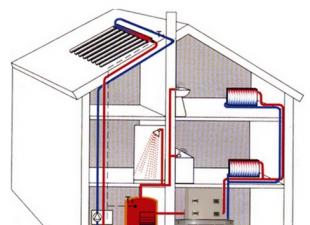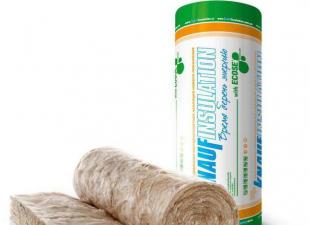The modern market of insulating materials is quite dynamic. The requirements for thermal insulation of premises are changing, SNiPs are being revised, the requirements of customers for energy-saving parameters of construction projects are being tightened. In response, the range of materials is expanding, and popular models are improving their qualities.
One of the discoveries in the field of insulation was reflective thermal insulation. The material is produced in rolls and has universal properties that simultaneously combine the functions of heat, steam, hydro and sound insulation.
The structure and principle of action of penofol
Penofol foil - a multilayer material from the class of reflective insulation. The main functions of penofol are to protect structures from drafts and wind, moisture and condensates, vapors rising up from the lower tiers of the structure, as well as from external sounds and noises. Penofol is a universal insulating material, since it has the qualities of sound, steam, hydro and thermal insulation. These properties are determined by the structure of the material and the technology of its production.
The basis of the heat insulator is polyethylene foam with closed pores, which are filled with air. Polyethylene foam is used in various thicknesses, densities and structures. On one or both sides (depending on the purpose of the penofol), the polyethylene is covered with aluminum foil. The foil is pre-treated - polished to the maximum reflection coefficient (97% or more). Aluminum foil is applied by thermal welding, which ensures reliable adhesion of materials.
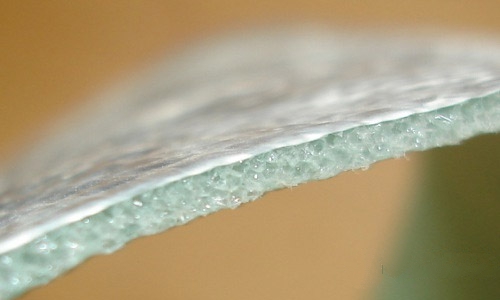
The base thickness is 2-10 mm, the foil thickness is about 12-30 microns. The total thickness of penofol can reach 40 mm - the use of such an "insulator" is relevant only for regions with harsh climatic conditions.
The principle of operation of penofol is based on the work of the "Dewar vessel". James Dewar, at the beginning of the 20th century, found out that any substance has a certain resistance to heat transfer. Regardless of the value of this indicator, the material can only slow down the process of heat transfer, but not stop it completely. At the same time, the substance accumulates heat waves, thereby accumulating energy in itself. After a while, supersaturation occurs, and the material begins to generate heat.
During the experiments, James Dewar identified a number of substances that tend not to absorb heat energy, but to reflect it. These materials include: precious metals (gold, platinum, silver) and clean, polished aluminum. The rays of heat, reaching the surface of the metal, are reflected by almost 99%. But, "reflectors" are good conductors of heat, so they must be used in tandem with materials capable of absorbing heat.
An ordinary thermos has a similar principle of operation, and the research of the scientist was the basis for the creation of spacesuits for astronauts and reflective heat-insulating materials.
The use of one- and two-sided reflective insulators reduces the cost of heating the premises in winter, and in summer, in hot weather, slows down the heating of the house.
Advantages and disadvantages of thermal insulation material
The advantages of penofol include the following qualities:
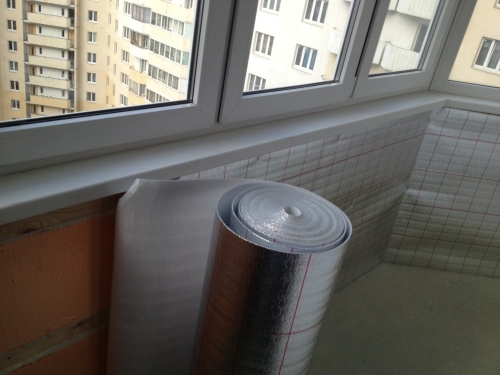
With all the variety and undeniable advantages, the insulation also has some disadvantages:
- Excessive softness limits the scope of penofol. It is not suitable for wall insulation under plaster or wallpaper.
- To fix the penofol, you may need special glue. Self-adhesive penofol is deprived of this minus.
- Despite the good performance, experts do not recommend using penofol as an independent insulation for the external walls of buildings. It is attached as an additional layer to reflect thermal energy and protect the structure from moisture.
Penofol: specifications
Penofol has the following characteristics:
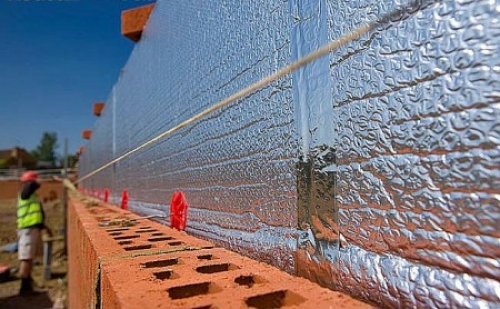
- spread of operating temperatures ranging from -60°С to +100°С;
- coefficient of thermal reflection of the surface 95-97%;
- the thermal conductivity coefficient depends on the operating conditions and ranges from 0.037-0.052 W / m ° C;
- water absorption by volume - 0.35-0.7% - this indicator indicates reliable protection of frame elements and ceilings from moisture penetration;
- with a material thickness of 4 mm, the specific gravity is 44-74 kg / m3 (the value depends on the type of penofol);
- vapor permeability is not more than 0.001 mg / m h Pa - this value allows us to call penofol a good barrier to evaporation;
- ultimate strength during compression 0.035 MPa;
- specific heat capacity 1.95 J/kg°C;
- sound absorption - not less than 32 dB.
Scope of penofol
Universal penofol is suitable for warming summer country houses and thermal insulation of high-rise buildings. The characteristics of the material determined its wide popularity and demand, both in the construction of fundamental buildings and in the repair work at home.
Penofol is used for the following purposes:
- Thermal insulation:
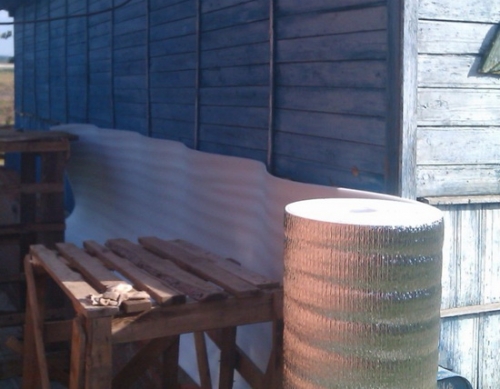
- Processing of building elements:

Important! Penofol reflective will not only help to keep the heat in the house as warm as possible in winter. Laid under the roof, it will not allow the scorching summer heat to penetrate into the room.
Types of foil penofol
Manufacturers offer several types of penofol for different purposes. In the traditional classification, three classes of material are distinguished:
- Type A- one-sided penofol (a layer of aluminum film is applied on one side of the foamed polyethylene). This type is mainly used as an addition to the main thermal insulation - polystyrene foam or styrodor.
- Type B- double-sided foil foam, universal and can be used as a stand-alone insulation.
- Type C- self-adhesive type of insulation. On the one hand - a reflective layer of aluminum, and on the other - polyethylene foam with moisture-resistant adhesive, protected by a sticker. Penofol self-adhesive is convenient for finishing inconvenient areas of the structure, so additional installation tools are not required for work.
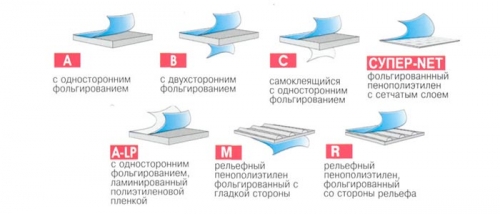
In addition to standard types of penofol, technologists have developed a number of modifications that have taken their niche in the construction market:
- ALP type- laminated penofol, one of the foil sides of the insulation is covered with a polyethylene film; ALP class penofol is used for insulation of agricultural buildings that are operated in a slightly aggressive environment;
- M types And R- insulation with one-sided foiling, has a relief surface;
- penofol AIR designed for the arrangement of air outlet structures;
- Penofol Super NET(translated from English as “network”) - the main task is heat and vapor insulation of pipelines, air outlets and heating mains.
Choosing the optimal type of penofol
The main parameters to consider when choosing penofol:
- type of insulation (one- or two-sided);
- manufacturer company (it should be noted that "Penofol" is the name of the brand, not the type of insulation; other construction companies manufacture it under other commercial names);
- price category;
- material thickness.

- The cost of penofol is primarily affected by its thickness and the number of aluminum layers. Standard material sizes: 3,4,5,8 and 10 mm. One-sided penofol with dimensions of 3 and 4 mm type A can be purchased for 50 rubles / m2. Penofol 10 mm type B is considered the most durable and expensive, its price ranges from 100-130 rubles / m2.
- In the assortment of construction stores there is the Penofol 2000 marking - a cheaper analogue of the standard penofol (you can buy material at a price of 35 rubles / m2). However, experts note that penofol 2000 is inferior in strength to branded insulation.
- The optimal ratio of cost and performance is demonstrated by 5 mm penofol (the price of such a heater is about 70 rubles / m2).
- Penofol type A is suitable for insulating roofs, basements, saunas, balconies, ceilings and walls, class B is better for arranging wood flooring, and type C penofol for insulating car interiors and metal structures.
Video: comparative characteristics of penofol and its analogues
Features of laying penofol
The maximum effect of foam insulation will be achieved subject to certain rules:
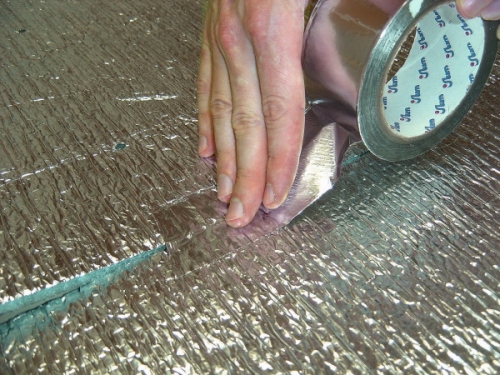
Important! When attaching penofol, one should not forget that aluminum foil is an excellent conductor of electric current. Therefore, with a close location of the insulation with electrical wiring, care must be taken to carefully isolate the wires.
By choosing foil penofol, the characteristics of which correspond to the operating conditions of the material, you can not use additional vapor, heat and waterproofing. In addition, it will turn out to save on the purchase of auxiliary and installation tools.
 budivel.ru About the insulation and heating of the house.
budivel.ru About the insulation and heating of the house.

